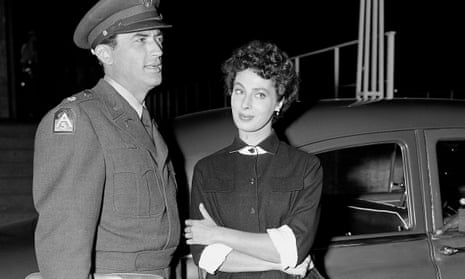The actor Rita Gam, who has died aged 87, starred in many films from the 1950s onwards, alongside famous names including Gregory Peck and Jane Fonda. When just 24, with modest stage and television experience, she was cast opposite another leading figure, Ray Milland, for her Hollywood debut in what the publicity described as “the only motion picture of its kind”.
This was The Thief (1952), a cold war spy film devised by the writer-director Russell Rouse in the style of Charlie Chaplin’s City Lights (1931) as a sound film entirely without dialogue. Indeed, Rouse went one better in having no intertitles, the cards using written words to set the scene or supply the dialogue.
There was a fine score and sound effects, but no conversation – even passers-by could not be heard, and public announcements were rendered even less intelligible than normal. The experiment created an eerie sense of isolation for the central character, a scientist who has given secrets to the Russians and is sought by the FBI. Gam, billed only as The Girl, is the final character to close – literally – a door on him, leaving him isolated. Her role brought her a Golden Globe nomination as the most promising newcomer.
In a further political thriller, Night People (1954), she played opposite Peck. For a while her exotic looks led to her being typecast in epics and westerns in the US, and frequently in Europe.
She could often be seen in television series such as The Rockford Files and in stage plays, but possibly her most famous role came in real life as one of the bridesmaids to Grace Kelly at her wedding in 1956 to Prince Rainier of Monaco. Gam gave innumerable interviews about that event and their friendship and appeared in documentaries including Grace Kelly: The American Princess (1987).
Her career in movies included the title role in Saadia (1954), Albert Lewin’s love story set in Morocco, in which rivals Mel Ferrer and Cornel Wilde tussled politely for her affections.
Douglas Sirk’s brisk epic Sign of the Pagan (1954) saw her somewhat overwhelmed by Jack Palance as Attila the Hun, wreaking havoc on the Christian empire. In Magic Fire (1955), a biopic of Richard Wagner, she played the key role of Cosima Liszt, the composer’s wife, though the venture was undermined by a confusion of accents. A high camp western, Mohawk (1956), directed by Kurt Neumann, was followed by a trip to Italy for Costa Azzurra (1959) with Alberto Sordi, and Gam stayed for the less than spectacular Hannibal with Victor Mature. On returning to Hollywood she played the villainously ambitious Herodias in King of Kings (1961), Nicholas Ray’s life of Christ.
She then appeared in an adaptation of Sartre’s Huis Clos, called No Exit (Sinners Go to Hell in the US), directed by Tad Danielewski. It premiered at the 1962 Berlin film festival. Gam and Viveca Lindfors won a Silver Bear award for their roles as Inèz and Estelle, two of the three characters confined for eternity in a shabby room – a version of hell as other people.
Sadly, the chilling work did little to enhance Gam’s film career and she worked in television until the fine thriller Klute, starring Fonda and Donald Sutherland, and directed by Alan J Pakula, and Otto Preminger’s tastelessly funny Such Good Friends (both 1971). She was reunited with Peck in a western, Shoot Out (also 1971), appeared in Ivan Passer’s satire Law and Disorder (1974), and went to Puerto Rico for a genuine oddity, The Gardener (later Garden of Death, 1974), with Joe Dallesandro rearing exotic plants, poisoning women and eventually metamorphosing into a tree.
Born in Pittsburgh, Rita was the daughter of Milton MacKay, from Alsace-Lorraine, and his wife, Belle (nee Fately), from Romania. Her father died when she was four, and she later took the name of her Russian-born stepfather, Benjamin Gam. She was brought up in New York, and at the age of 20 started working on Broadway and became involved in the Actors Studio. In 1949 she married the up-and-coming director Sidney Lumet: they divorced in 1955, before Lumet made his celebrated feature debut with 12 Angry Men. In 1956 she married the publisher Thomas Guinzburg, with whom she had a daughter, Kate, and son, Michael. This marriage also ended in divorce, in 1963.
Occasional later films included the thriller Distortions (1987), a horror film, Midnight (1989), with Tony Curtis, and a Canadian-Japanese film about the boycotting of the Moscow Olympics, Rowing Through (1996). A year later she provided the commentary for a documentary, Monaco, and in 2001 appeared in a television biography of her fellow actor Shelley Winters.
She is survived by her children and three granddaughters.

Comments (…)
Sign in or create your Guardian account to join the discussion